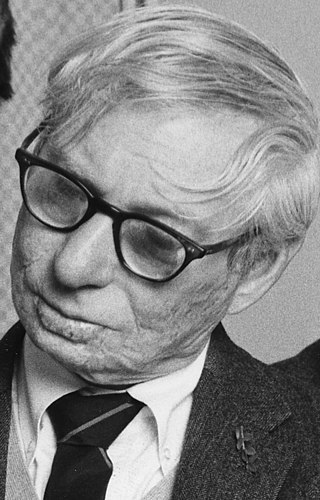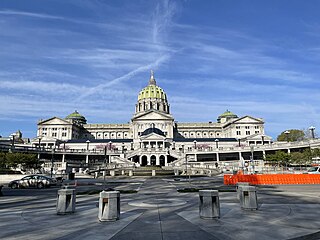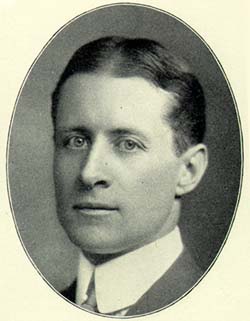Biography
He was born in Pittsburgh, Pennsylvania, the son of Hungarian immigrants Armin and Rachel Hartmann Bendiner. [1] He was the second-oldest of five children, and raised in a cultured Orthodox Jewish household. [2] The family moved to Philadelphia when he was a boy, where he attended public schools, and graduated from Northeast High School in 1917. [1]
Bendiner won a scholarship to the Pennsylvania Museum School, [3] but left after a year to enlist in the Students' Army Training Corps at the University of Pennsylvania. He was a sergeant and still stationed in Philadelphia when World War I ended in November 1918, [4] : 316 but his service earned him automatic admission to Penn. [2] He studied architecture there under Paul Philippe Cret, and graduated with a bachelor's degree in 1922. [1]
Architect

Following graduation, he was employed as a draftsman in the office of Stewardson & Page for a couple years, before being hired by Cret. [1] Bendiner worked on major Cret projects such as the Detroit Institute of Arts (1927), the Hartford County Courthouse (1929), and the Folger Shakespeare Library (1932). [4] : 286 He also did early work on three battle memorials for American military cemeteries in Europe: the Château-Thierry American Monument (1937) and the Somme American Cemetery and Memorial (1937), in France; and the Flanders Field American Cemetery and Memorial (1937), in Belgium. [4] : 204
While working as a Cret draftsman during the day, Bendiner completed a master's degree in architecture from Penn at night. [4] : 285 Penn purchased a former piano factory at the southwest corner of 33rd & Walnut Streets to house the Moore School of Engineering. Cret's office designed alterations to the building, 1925–1926, with Bendiner as architect in charge. He took a year off to attend the American Academy in Rome, 1928–1929. [1]
Bendiner left the Cret office in 1933, [1] and opened his own architectural office in Philadelphia, which remained in operation until his retirement in 1961. [1] Finding clients was a challenge during the Great Depression, and commissions were few and far between. [2] Most of his completed designs during this period were alterations to houses and commercial buildings, [1] and the third story addition to the Moore School (1940). [5]
Archaeological draftsman
The University of Pennsylvania Museum sponsored archaeological excavations at Tepe Gawra and Khafaji, Iraq, in 1937. Bendiner went along as project draftsman on the 8-month excavation, drawing site plans and sections of the dig, and making measured drawings of the artifacts uncovered. [6] He again worked as an archaeological draftsman on an excavation in Tikal, Guatemala, in 1960. [6]
Caricaturist
Hungarian-American violinist Arthur Hartmann was Bendiner's uncle, and his maternal grandfather had also been a violinist. In 1938, Bendiner pitched himself to the Philadelphia Evening Bulletin as a music critic, but with a twist: each review would be illustrated by his caricature of the featured musician, drawn during the performance. [2] His caricatures became highly popular, and he reproduced them as lithographs, earning him the moniker "The Hirschfeld of Philadelphia." [7] He retired from music criticism in 1946, and collected his favorite reviews and caricatures in the 1952 book Music to My Eyes. [7]
Muralist
Bendiner's first mural commission was for Gimbel Brothers Department Store in Philadelphia, in 1952. The subject was a musical event that had occurred thirteen years earlier: Sergei Rachmaninoff performing as piano soloist in his Symphony No. 3 with the Philadelphia Orchestra. [7] Rachmaninoff had chosen the Philadelphia Orchestra under conductor Leopold Stokowski to perform the work's world premiere, November 6, 1936. [8] He returned three years later to perform Symphony No. 3 under conductor Eugene Ormandy and to make the first recording of it. [8] The mural depicted the December 2, 1939 concert at the Academy of Music, the composer/pianist's final appearance with the orchestra. [8] Rachmaninoff died in 1943. The mural is illustrated in Bendiner's autobiography. [4] : 21
Fidelity Bank commissioned Bendiner to paint twin murals for its Rittenhouse Square branch: Rittenhouse Square, 1856 and Rittenhouse Square, 1956. [4] : 188, 316 He also painted murals for the offices of Blue Cross of Greater Philadelphia (1959); and The Story of Man for the University of Pennsylvania Museum. [7]
Author
Bendiner's books include:
- Music to My Eyes" (1952)
- Bendiner's Philadelphia (1964)
- Translated from the Hungarian: Notes toward an Autobiography (1967)












